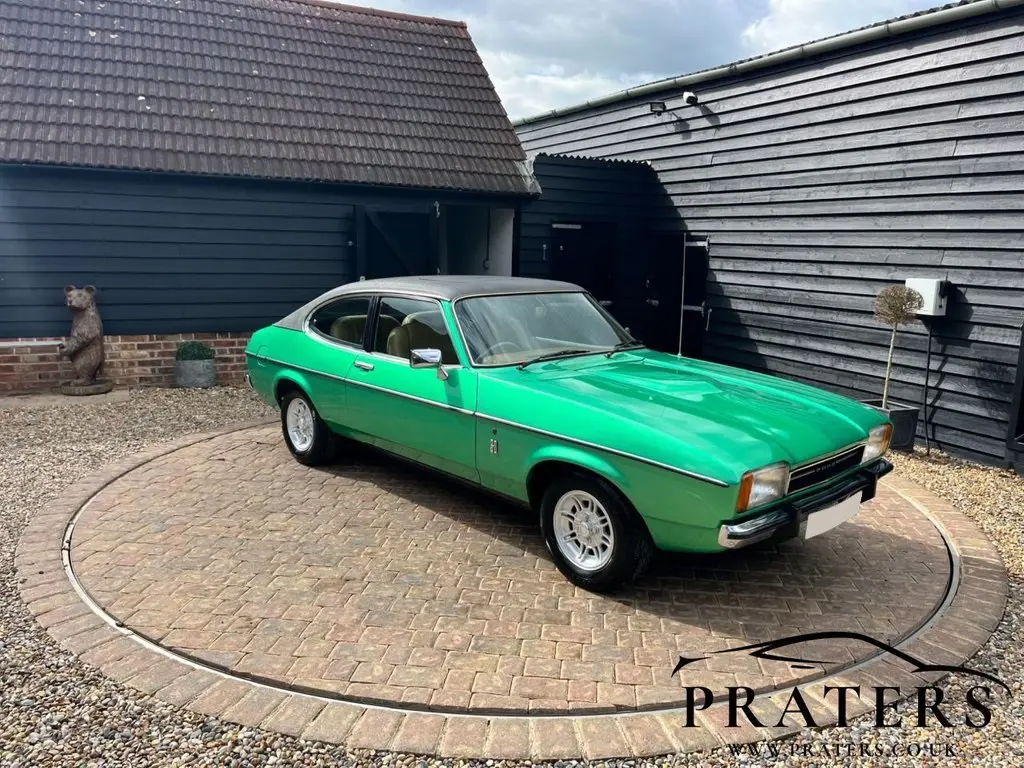FIT FOR A PROFESSIONAL – THE FORD CAPRI GHIA MK. II
11 December 2023
In 1976, this Ford Capri Mk. II Ghia, offered for sale by Praters, represented the high life to the discerning motorists; on seeing that shield badge on the front wings, neighbours and business colleagues would regard you with awe as a member of that exclusive club – 'The Fellowship of Ghia'. Such a Capri belonged on the driveway of a neo-Georgian 'Executive' house, with an avocado bathroom suite.

Ford introduced the second-generation Capri on the 25th February 1974 and there was also a new flagship. In place of the outgoing Capri GXL, the 2 and 3-litre Mk. IIs were now available as a Ghia. Ford acquired the Turin design house Carrozzeria Ghia in 1970, and four years later, the shield logo adorned the top of the range Capri and Granda.
The Capri Ghia had alloy wheels, a push-button radio, tinted glass, and a sunroof as standard. The seats were upholstered in the finest Rialto cloth available to humanity, while genuine timber decorated the cabin. To put such luxuries in context, October 1975 saw Ford launch the entry-level Capri 1300. Here was a car devoid of such distracting features as "servo assisted brakes", "reclining front seats", and "driver's door mirror". The brochure was reduced to listing "black door handles" and "black loop pile carpet" as special features.
To the owner of the Capri 1300, a Ghia was a beacon of aspiration, which is what Dagenham probably intended – a status symbol to be reached only after climbing the ranks of the L, the XL, and the GT. Regarding British rivals, the MGB GT V8 was a different sort of coupe, as was the Vauxhall Firenza 'Droop Snoot'. The Reliant Scimitar was closer in image as a sporting three-door four-seater but cost £3,240 compared to £2,609 for the Capri in 1974.
Frank Page of The Observer found the Capri Mk. II's gearchange was "slick and smooth", while the 3-litre version felt "eager to go". He also thought, "How the designers of the Reliant Scimitar GTE must be flattered!" and Clive Richardson compared the Capri Ghia with its Tamworth competitor in 1974 for Motor Sport. He wrote:
One thing which Ford have not been able to include in the Ghia, and never will be able to do, is that aura of middle-class respectability which the Scimitar GTE exudes, for it has a look of quality, elegance and individuality which Henry Ford's mass-production lines would find completely unviable to emulate.
But the average Capri Ghia owner had few Margot Ledbetter-style aspirations, for their dreams were more focused on good living, wine bars, and wearing aviator sunglasses in Fine Fare. To be fair, Richardson did think “For everyday use in traffic and town conditions (except for parking, when the rear three-quarter panels are a nuisance), the much lighter to drive Capri was preferred".
The following year Car tested the Capri Ghia against the formidable opposition of the Alfa Romeo Alfetta 1800 GT Coupe and the Audi 100S Coupe. Somewhat inevitably, they opted for the Alfa (in 1975, a Car reader would not have expected otherwise). Still, they thought the Capri would "unquestionably satisfy the person who wants good appearance and the impression of luxurious equipment, coupled with tidy straight line acceleration and a sporty exhaust note".
This was precisely what Capri Ghia buyers wanted from their cars, and at £3,132, the Ford was also the cheapest of the trio; the Alfa Romeo cost £3,498, and the Audi was £3,890. When the Capri Mk. III replaced the Mk. II in 1978, the Ghia epitomised 'the executive lifestyle' as much as owning a fondue set.
And when CI5 issued Bodie with a Ford PR Capri Mk. II it proved the perfect combination of actor and car. Forget Steve McQueen and his Mustang – Lewis Collins driving an Arizona Gold Capri Ghia is true style.
With Thanks To: Praters - https://www.praters.co.uk/
